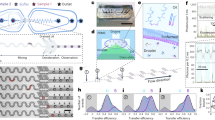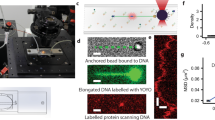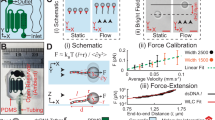Abstract
We present an automated microfluidic platform that performs multisecond observation of single molecules with millisecond time resolution while bypassing the need for immobilization procedures. With this system, we confine biomolecules to a thin excitation field by reversibly collapsing microchannels to nanochannels. We demonstrate the power of our method by studying a variety of complex nucleic acid and protein systems, including DNA Holliday junctions, nucleosomes and human transglutaminase 2.
This is a preview of subscription content, access via your institution
Access options
Subscribe to this journal
Receive 12 print issues and online access
$259.00 per year
only $21.58 per issue
Buy this article
- Purchase on Springer Link
- Instant access to full article PDF
Prices may be subject to local taxes which are calculated during checkout



Similar content being viewed by others
References
Ha, T. Cell 154, 723–726 (2013).
Roy, R., Hohng, S. & Ha, T. Nat. Methods 5, 507–516 (2008).
Milles, S. & Lemke, E.A. Bioessays 35, 65–74 (2013).
Schuler, B. & Eaton, W.A. Curr. Opin. Struct. Biol. 18, 16–26 (2008).
Wang, Y.M. et al. Proc. Natl. Acad. Sci. USA 102, 9796–9801 (2005).
Quake, S.R. & Scherer, A. Science 290, 1536–1540 (2000).
Sui, G. et al. Anal. Chem. 78, 5543–5551 (2006).
Gambin, Y. et al. Nat. Methods 8, 239–241 (2011).
Shi, X., Lim, J. & Ha, T. Anal. Chem. 82, 6132–6138 (2010).
Lemke, E.A. et al. J. Am. Chem. Soc. 131, 13610–13612 (2009).
Müller, J.D., Chen, Y. & Gratton, E. Methods Enzymol. 361, 69–92 (2003).
Holden, S.J. et al. Biophys. J. 99, 3102–3111 (2010).
Kapanidis, A.N. et al. Proc. Natl. Acad. Sci. USA 101, 8936–8941 (2004).
Gansen, A. et al. Proc. Natl. Acad. Sci. USA 106, 15308–15313 (2009).
Milles, S. et al. EMBO Rep. 14, 178–183 (2013).
Clouthier, C.M., Mironov, G.G., Okhonin, V., Berezovski, M.V. & Keillor, J.W. Angew. Chem. Int. Ed. Engl. 51, 12464–12468 (2012).
Siegel, M. et al. PLoS One 3, e1861 (2008).
Keppler, A., Pick, H., Arrivoli, C., Vogel, H. & Johnsson, K. Proc. Natl. Acad. Sci. USA 101, 9955–9959 (2004).
Chung, H.S., McHale, K., Louis, J.M. & Eaton, W.A. Science 335, 981–984 (2012).
McKinney, S.A., Déclais, A.C., Lilley, D.M. & Ha, T. Nat. Struct. Biol. 10, 93–97 (2003).
Milles, S. & Lemke, E.A. Biophys. J. 101, 1710–1719 (2011).
Lowary, P.T. & Widom, J. J. Mol. Biol. 276, 19–42 (1998).
Lee, K.-M. & Narlikar, G. Curr. Protoc. Mol. Biol. 54, 21.6 (2001).
Roy, I., Smith, O., Clouthier, C.M. & Keillor, J.W. Protein Expr. Purif. 87, 41–46 (2013).
Gopich, I.V. & Szabo, A. J. Phys. Chem. B 111, 12925–12932 (2007).
Vogelsang, J. et al. Angew. Chem. Int. Ed. Engl. 47, 5465–5469 (2008).
Qian, H., Sheetz, M.P. & Elson, E.L. Biophys. J. 60, 910–921 (1991).
Acknowledgements
This study was technically supported by the Advanced Light Microscopy and Protein Expression Core facilities of EMBL. We thank C. Merten for the good clean-room collaboration. E.A.L. acknowledges funding by the Emmy-Noether program of the Deutsche Forschungsgemeinschaft (DFG); S.T., a fellowship of the Darwin Trust of Edinburgh; S.M., a fellowship of the Boehringer Ingelheim Fonds; and G.F. receives support from EMBL interdisciplinary postdoctoral program (EIPOD) and Programa VALi+d of the Generalitat Valenciana fellowships.
Author information
Authors and Affiliations
Contributions
S.T. and V.V. designed research, performed experiments, contributed new reagents and analytic tools, analyzed data and wrote the paper; N.B. contributed new reagents and analytic tools and analyzed data; G.F., S.M. and M.A. contributed new reagents or analytic tools; and E.A.L. designed research, analyzed data and wrote the paper.
Corresponding author
Ethics declarations
Competing interests
The authors declare no competing financial interests.
Supplementary information
Supplementary Text and Figures
Supplementary Figures 1–9, Supplementary Table 1 and Supplementary Notes 1–3 (PDF 2207 kb)
SWIFT of 2400bp DNA labeled with Alexa 647 using EPI illumination
2,400bp dsDNA labeled with Alexa647 was imaged in a SWIFT device in epifluorescence mode. The channels are oriented horizontally. Arrow shows the direction of flow. Please compare to Supplementary Video 2. (Image size corresponds to 512*512 pixel or 42.5 μm * 42.5 μm). Display Rate: 15 frame/s (AVI 9463 kb)
SWIFT of 2400bp DNA labeled with Alexa 647 using TIRF illumination
The same sample as in Supplementary Video 1 (2,400bp dsDNA labeled with Alexa647) was imaged in a SWIFT device in TIRF mode directly after Supplementary Video 1 was recorded. The channels are oriented horizontally. Arrow shows the direction of flow. The SNR in TIRF is more than 5 times higher as compared to epifluoresence. (Image size corresponds to 512*512 pixel or 42.5 μm * 42.5 μm). Display Rate: 15 frame/s (AVI 9358 kb)
Time dependent simulation of deoxygenation on SWIFT
Time dependent simulation (finite element simulation in Comsol multiphysics) was carried out using the cross section of nano-channels with control layer on the top surrounded with PDMS block. Initial value for oxygen concentration was set to 21% oxygen in all features. Boundary conditions were set with 0% oxygen for control channel and 21 % for the PDMS block and nano-channels. Lower surface of nano-channels has been set to no flux condition (impermeable to gas). The (*.gif) movie shows the simulation which has been run for 0.1 sec with a resolution of 0.002 seconds. Within this time, the nano channels are completely saturated with N2. (MP4 769 kb)
SWIFT tracking DNA labeled with Alexa 647 with N2 in control channel
2,400 bp dsDNA labeled with Alexa647 was with SWIFT using 660 nm laser excitation and exposure time of 30 ms per frame. Consecutives frames were recorded with lag time of 65 ms (15 fps). Channels of the SWIFT device were collapsed with N2 in the control channel. The channels are oriented horizontally. (Image size corresponds to 512*512 pixel or 42.5 μm * 42.5 μm). Display Rate: 20 frame/s. (AVI 31620 kb)
SWIFT of FRET labeled 2400bp DNA
2,400 bp dsDNA end labeled with Alexa488 and Alexa594 at 12 bp apart was imaged using SWIFT with 488 nm laser excitation and exposure time of 20 ms per frame. Consecutives frames were recorded with lag time of 56 ms (17 fps). Shown in the movie are the color overlaid frames of signal collected in D and A channel. The channels are oriented horizontally. (Image size corresponds to 512*512 pixel or 42.5 μm * 42.5 μm). Display Rate: 20 frame/s. (AVI 10339 kb)
SWIFT of NS
Nucleosomes assembled using 170 bp Widom DNA labeled with Alexa488 and Alexa594 were with SWIFT using 488 nm laser excitation and exposure time of 2 ms per frame. The consecutives frames were recorded with lag time of 10 ms (100 fps). Shown in the movie are the color overlaid frames of signal collected in D and A channel. The channel is oriented horizontally. (Image size corresponds to 256*64 pixel or 42.5 μm * 10.625 μm). Display Rate: 20 frame/s. (AVI 1777 kb)
SWIFT of Transglutaminase 2
hTG2 labeled with Alexa488 and Alexa594 at N and C termini via CLIP and SNAP tag respectively were imaged on a custom-built TIRF setup with 488 nm laser excitation and exposure time of 2 ms per frame. The consecutives frames were recorded with lag time of 10 ms (100 fps). Shown in the movie are the color overlaid signals collected in D and A channel. The channel is oriented horizontally. (Image size corresponds to 256*64 pixel or 42.5 μm * 10.625 μm). Display Rate: 20 frame/s. (AVI 1140 kb)
SWIFT of Holliday junction in 50 mM MgCl2
Holliday junction labeled with Alexa488 and Alexa594 at b and h strand respectively were imaged on a custom-built TIRF setup in buffer containing 50 mM MgCl2 with 488 nm laser excitation and exposure time of 2 ms per frame. The consecutives frames were recorded with lag time of 10 ms (100 fps). Shown in the video are color overlaid signals collected in D and A channel. The channel is oriented horizontally. (Image size corresponds to 256*64 pixel or 42.5 μm * 10.625 μm). Display Rate: 20 frame/s. (AVI 1759 kb)
SWIFT on commercial microscope
201 bp dsDNA labeled with Alexa647 imaged on a commercial Olympus CellR TIRF microscope (Olympus, equipped with a Hamamatsu Image EM CCD camera; a 60x oil immersion objective; and quadband dichroic and emission filters) excited with a 640 nm laser. The exposure time was 20 ms and frames were acquired at 54 ms intervals. Channels are oriented horizontally. (Image size corresponds to 1024*1024 pixel. Display Rate: 15 frame/s. (AVI 5612 kb)
Rights and permissions
About this article
Cite this article
Tyagi, S., VanDelinder, V., Banterle, N. et al. Continuous throughput and long-term observation of single-molecule FRET without immobilization. Nat Methods 11, 297–300 (2014). https://doi.org/10.1038/nmeth.2809
Received:
Accepted:
Published:
Issue Date:
DOI: https://doi.org/10.1038/nmeth.2809
This article is cited by
-
Stable trapping of multiple proteins at physiological conditions using nanoscale chambers with macromolecular gates
Nature Communications (2023)
-
Label-free nanofluidic scattering microscopy of size and mass of single diffusing molecules and nanoparticles
Nature Methods (2022)
-
ABEL-FRET: tether-free single-molecule FRET with hydrodynamic profiling
Nature Methods (2021)
-
Förster resonance energy transfer and protein-induced fluorescence enhancement as synergetic multi-scale molecular rulers
Scientific Reports (2016)
-
Real-time submillisecond single-molecule FRET dynamics of freely diffusing molecules with liposome tethering
Nature Communications (2015)



